(PCC) Program on Chinese Cities – Thoughts on Overseas Travels Series
Authors: Fei Zhong,
Associate Professor at the School of Architecture, Nanjing Tech University, Visiting Scholar at UNC, research direction in urban planning and urban design, urban comprehensive disaster prevention planning. zhongzhong219@gmail.com
Safety is the foundation of urban development, and safe communities are the cornerstone for cities to effectively resist disasters. As a grassroots platform integrating resources from all parties, communities are the front line for departments to carry out disaster prevention and reduction work. Moreover, as the place of residents’ daily lives, the disaster prevention safety of the community is directly related to the safety and quality of residents’ lives. Since the 1990s, the United States has been committed to building “Disaster Resistant Communities” (Disaster Resistant Community), which may provide references for China’s community safety and disaster prevention construction.
The “Disaster Resistant Community” concept appeared in the 1990s, when the international community paid increasing attention to environmental issues and the importance of disaster reduction in disaster management was recognized, and important concepts such as sustainable development were also proposed during this stage. In 1994, Donald Geis first proposed the concept of “Disaster Resistant Community” at the National Earthquake Conference in the United States. As the basic unit of society, if handled properly, communities can become an important channel to enhance people’s awareness and ability of disaster prevention, self-rescue, and mutual rescue in the event of a disaster. After the “9·11” terrorist attacks, the whole United States actively carried out disaster prevention and reduction work with the community as the basic unit, building “Disaster Resistant Communities”, taking various disaster prevention steps and measures within the community, reducing the possibility of community disasters, enhancing the disaster prevention awareness of community members, strengthening the community’s disaster prevention and relief capabilities, and thereby maintaining urban public safety. After years of construction, “Disaster Resistant Communities” have achieved good results and accumulated successful experiences.
1. Construction of “Disaster Resistant Communities” in the United States
Since the late 1980s, the United States has experienced multiple natural disasters. Because disaster management emphasized disaster response capability and neglected the importance of disaster reduction, although the disaster prevention and rescue budget increased year by year, disaster losses did not decrease but increased. In response to the increasing natural disasters and to address its own organizational crisis issues, the Federal Emergency Management Agency (FEMA) launched the “National Disaster Mitigation Strategy” in 1995, aiming to encourage states and local governments to adopt the central government’s disaster mitigation policies and plans to reduce the increasing disaster relief and post-disaster recovery costs. In 1996, FEMA changed its previous engineering-focused disaster prevention strategy and proposed a new program called “Disaster Mitigation Community Activity”, later renamed “Project Impact” (Figure 1), which required the establishment of partnerships including all stakeholders, identification, and reduction of risks, and encouragement of community-initiated actions to reduce the probability of disasters and minimize the loss of life and property. Since its promotion in 1997, about 250 communities in all states across the United States have become “Project Impact” communities, and 7 demonstration communities have been established. The demonstration communities have completed the goals set by “Project Impact”, and achieved good disaster mitigation effects, and the concept of disaster prevention and reduction has become an important guiding idea for FEMA’s work.
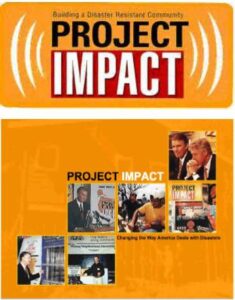
2. Community characteristics promote the construction of “Disaster Resistant Communities”
American communities are different from “streets” in Chinese cities and do not exist as a grassroots management unit (administrative division). Federal states and various cities and towns all have their unique community governance methods, but in community development and management, they basically adopt the operation method of “government responsible for planning guidance and financial support, community organizations responsible for specific implementation”. Specific affairs are handed over to community organizations and civil groups, with the government only responsible for macro-control. In the daily operation of the community, the community committee, community director, professional community workers, non-profit organizations, and community residents and volunteers are all subjects of community governance, responsible for community construction and development, enabling community governance subjects to operate specific affairs, implement a brand-new disaster mitigation plan based on the community, establish partnerships including all stakeholders (mainly within the community), identify and reduce disaster risks, and incorporate risk and risk avoidance into daily community decision-making.
3. Four stages of building a “Disaster Resistant Community”
3.1 Establishing Community Partnerships
Communities actively establish partnerships with government, public sectors, private enterprises, schools, and residents, committed to promoting community disaster prevention, especially those communities that are plagued by disasters year-round, such as establishing partnerships with related institutions, will create a good foundation and environment for long-term implementation of community disaster prevention plans. For example, the city of Wilmington in North Carolina, at the beginning of the construction of the “Disaster Resistant Community”, established partnerships with New Hanover County Government, Cape Fear Public Utility Authority (CFPUA), US Environmental Protection Agency, Federal Emergency Management Agency, National Oceanic and Atmospheric Administration (NOAA), and many other organizations to seek support and help in formulating disaster defense strategies. At the same time, the community is committed to the promotion of “Project Impact”, creating relevant publications for distribution to community residents, organizing and planning committee meetings, forming groups to handle various issues, etc.
3.2 Community Disaster Possibility Assessment
The community disaster assessment conducted at this stage mainly identifies potential disaster sites within the community, studies the scope of disaster prevention, produces related community disaster maps, and fully utilizes existing public resources to find hidden dangers that are prone to disasters and take precautions. Consultation can be sought from government disaster prevention and rescue experts when assessing and identifying (Figure 2).
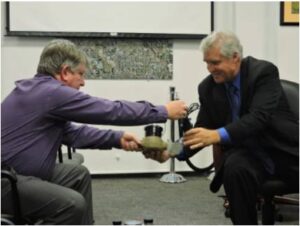
3.3 Identifying Risks and Formulating Community Disaster Mitigation Plans
Based on disaster assessment, ranking according to the size of potential losses caused by disasters, and formulating community disaster mitigation plans and short-term and long-term disaster mitigation strategies suitable for the community after consultation and discussion with community residents, preparing long-term “Project Impact” planning, and finding and applying for resources to practice disaster mitigation actions (Figure 3).
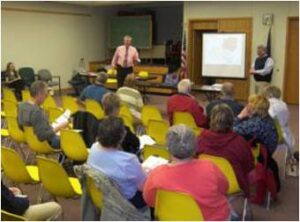
3.4 Establishing Disaster Resistant Communities (Success)
After establishing community partnerships, disaster assessment, and researching and formulating disaster mitigation plans, the remaining work is to complete the goal of establishing “Disaster Resistant Communities”, building a complete “Project Impact” framework, and sharing successful experiences (Figure 4). At this time, it is necessary to fully consider the methods by which “Disaster Resistant Community” can be practically promoted, so the community usually refers to and uses the resources, tools, and plans provided by FEMA to promote and implement disaster prevention and rescue training for community residents and conducts regular drills, continuously improving and enhancing the community’s disaster prevention and reduction capabilities, and even joining the mass media as partners or sponsors to establish speaking units.
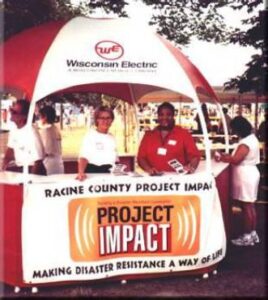
4 Case Introduction
Wilmington is a port city located in southeastern North Carolina, belonging to New Hanover County, the eighth-largest city in North Carolina, with a population of about 260,000. The city has always been threatened by rising sea levels and is one of the first demonstration points for the construction of disaster-resistant communities.

Due to the coastline, the area faces more and more uncertainties related to climate conditions, such as long-term atmospheric temperature rises that may lead to sea level rise and an increase in extreme storms, so an implementable adaptive strategy is urgently needed to reduce community disaster risks. The city first formulated an adaptive planning strategy for the community in the context of rising sea levels, trying to minimize the impact of future changes, considering measures that can be flexibly implemented, and obtaining more information about the trend of sea level rise, thereby enhancing the community’s resistance to this threat (Figures 6 and 7).
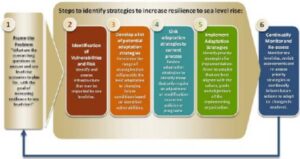
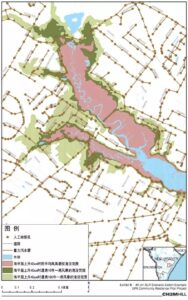
As previously mentioned, the city of Wilmington actively established project partnerships with major related institutions and carried out a series of work to guide community disaster defense work. This diversely organized proactive planning provided security for the residents and businesses of Wilmington to resist disasters.
5. Conclusion
China is a country with frequent disasters. Once a disaster occurs, only a limited amount of emergency and rescue work can be completed by professional and administrative forces. A better way should be to prevent problems before they occur. We can learn from the American experience, establish community-based disaster prevention mechanisms, set up community disaster prevention groups, assess community disaster risks, formulate targeted disaster prevention strategies, draw community disaster maps, regularly carry out disaster prevention propaganda and drills, etc. In the current unfavorable disaster situation, thinking about the tasks that communities can undertake in disaster prevention, reduction, and post-disaster reconstruction, researching and formulating methods and countermeasures to improve community disaster prevention and relief capabilities, will be an effective way to ensure urban safety.
